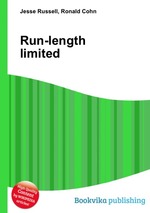Run-length limited
Jesse Russell Ronald Cohn
бумажная книга
High Quality Content by WIKIPEDIA articles! Run length limited or RLL coding is a line coding technique that is used to send arbitrary data over a communications channel with bandwidth limits. This is used in both telecommunication and storage systems which move a medium past a fixed head. Specifically, RLL bounds the length of stretches (runs) of repeated bits during which the signal does not change. If the runs are too long clock recovery is difficult, while if they are too short, the high frequencies might be attenuated by the communications channel. By modulating the data, RLL reduces the timing uncertainty in decoding the stored data which would lead to the possible errant insertion or removal of bits when reading the data back. Run length limited codes were widely used in hard disk drives until the mid-1980s and are used in digital optical discs such as CD, DVD, MD, Hi-MD and Blu-ray as the mechanism to ensure that the boundaries between bits can always be accurately found (preventing bit slip) while efficiently using the media to reliably store the maximum amount of data in a given space. Early disk drives used very simple encoding schemes, such as RLL (0,1) FM code, but higher density RLL (2,7) and RLL (1,7) codes became the de facto industry standard for hard disks by the early 1990s.


